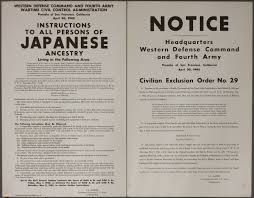Japanese American Internment
On February 19, 1942, President Franklin D. Roosevelt signed Executive Order 9066, authorizing the War Department to forcibly relocate approximately 110,000 persons of Japanese ancestry from California, Oregon, Washington, and Arizona to ten isolated inland “internment” camps. More than two-thirds of the evacuees were American citizens. The ten camps were:
- Manzanar, California
- Tule Lake, California
- Poston, Arizona
- Gila River, Arizona
- Granada, Colorado
- Heart Mountain, Wyoming
- Minidoka, Idaho
- Topaz, Utah
- Rohwer, Arkansas
- Jerome, Arkansas
In many cases, evacuees were given less than a week’s notice to relocate, forcing many to leave their property behind or sell to predatory second-hand merchants for rock-bottom prices. Before relocation to the camps, most evacuees spent several weeks or months held in temporary staging facilities—usually set up at horse racing tracks or fairgrounds.
In 1976, President Gerald Ford stated that internment was “wrong,” and a “national mistake” which “shall never again be repeated.” President Ronald Reagan signed the Civil Liberties Act of 1988, which allocated $20,000 in reparations to each surviving detainee. Approximately $1.6 billion was disbursed.
At no point during World War II was there even one act of sabotage or espionage committed by a Japanese American person.



442nd Regimental Combat Team
The 442nd was a segregated U.S. Army unit comprised of Japanese American Nisei that fought with uncommon valor in Italy, France, and Germany. The unit was preceded by the 100th Infantry Battalion, formed from 1,400 volunteers of the Hawaii National Guard. The soldiers of the 100th were sent to train at Camp Shelby, Mississippi, and first saw combat in Italy in September 1943. They were later folded into the 442nd Regimental Combat Team, which was initially comprised of 3,000 more volunteers from Hawaii and 800 from the mainland internment camps.
The 442nd sailed for Italy on May 1, 1944. Throughout the summer of 1944, they distinguished themselves in fierce fighting at Belvedere, Castellina, and around the Arno River. In September, the 442nd was transferred to France, and in October, fought ferociously in the Vosges Mountains, close to the German border. They liberated Bruyères, Biffontaine, and Belmont. In their most famous engagement, they rescued the Texans of the “Lost Battalion,” which had been cut off behind enemy lines. Over four days, the 442nd suffered 800 casualties in brutal fighting to rescue 211 surviving Texan soldiers. In the spring of 1945, the 442nd again fought with distinction in northern Italy where their offensives finally helped to break the German Gothic line near the end of the war.

The 14,000 men who ultimately served in the 442nd were awarded 9,486 Purple Hearts. The regiment won an unprecedented seven Presidential Unit Citations. Its members won 21 Medals of Honor, 52 Distinguished Service Crosses, 560 Silver Stars, and 4,000 Bronze Stars. Per capita, the 442nd is recognized as the most decorated unit in U.S. military history.

